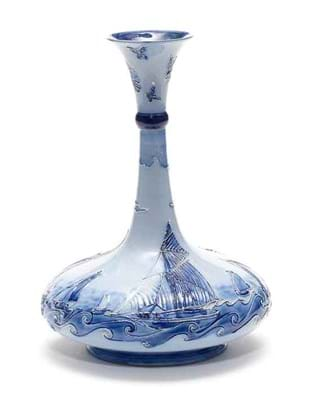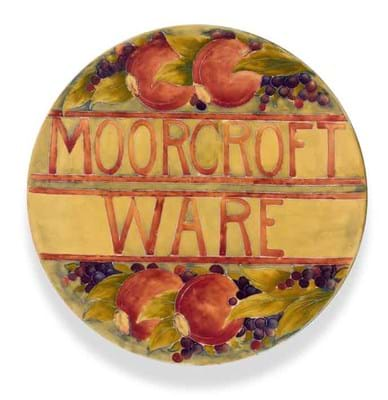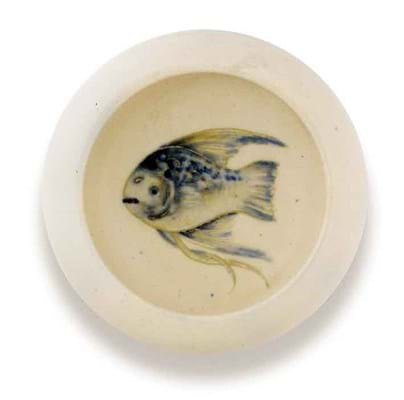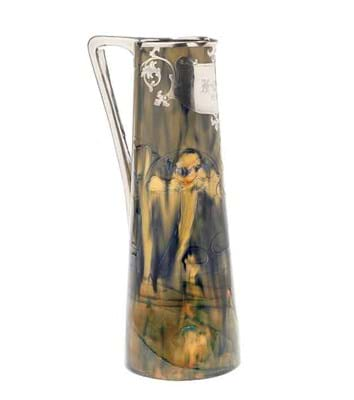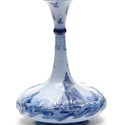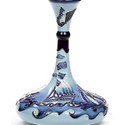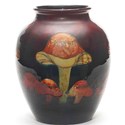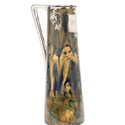That's no mean feat and testimony to the continued strength of this particular sector of the ceramics market.
Some £424,000 of this was provided on the morning of September 21 by their Ceramic Design from 1860 sale, the second of the year including their annual foray into contemporary ceramics that are specially commissioned for the sale. Twenty of these were Sally Tuffin creations from the Dennis Chinaworks and 77 lots were created by 11 other artist potters.
But this year the coffers were swollen by an additional £290,000, courtesy of a single-owner afternoon consignment of Moorcroft pottery - the collection of Richard Wright.
While the larger mixed-owner sale certainly had its popular highs (Martinware birds, Doulton flambé, Fairyland and other lustre and the Sally Tuffin 'specials'), it also had its lows. Some of the Doulton figurines and Ruskin ware are plainly not flavour of the month and it was these more sticky areas that resulted in 135 of the 424 lots (32 per cent by volume) failing to secure a buyer.
But Mr Wright's Moorcroft, assembled by a passionate collector over a 25 year period, clearly chimed with fellow enthusiasts. All bar 33 of the 289 lots got away to raise a total that was in line with the projected figure.
Enthusiasm for the subject, the thrill of the chase and the acquisitive urge is something that all serious collectors have in common and Richard Wright succinctly summarised this (and the particular attractions of Moorcroft) in his catalogue introduction.
"It was a chance encounter with Moorcroft pottery at a local auction that led me along the path to collectors' heaven" he said. "I quickly realised that here was an art form of such diversity and artistic merit that would satisfy my urge for collecting for the rest of my life. Its eclectic range of shapes and sizes, together with innovative colourways and patterns mean that a lifetime of collecting can only scratch the surface of an art pottery that has worldwide appeal."
The auction at Bonhams was his second dispersal through the salerooms following a dispersal of (largely damaged) wares through Gorringes in the early years of this century.
Mr Wright took his collecting odyssey around the world, buying in auctions at other Moorcroft-rich corners of what was once the British empire. Bonhams replicated this international quest when it came to marketing the collection, promoting in South Africa, Australia and in Canada where Mark Oliver held a two 'study days' in their Toronto saleroom.
Equally important for saleroom success, the collection was offered with realistic guides including estimates that were pitched lower than the prices Mr Wright paid. And along with rarer and more desirable patterns carrying four figure estimates, there was a good range of more affordable material offered with estimates in the low hundreds which opened the sale up to buyers at lots of different levels.
Indeed it was Bonhams' agreement to give adequate recognition to the lower value pieces (and lot them singly rather than as groups) that was instrumental in them securing the sale.
Certainly there was a good turnout with around 60 people in the room plus commissions and phone bidding (including contributions resulting from Mark Oliver's promotional trip to Canada.) And there seemed to be plenty of interest at all levels on the day.
However, as so often the case, there was one major player. The British Moorcroft dealer Wayne Hopton had set his sights on much of what was on offer here and succeeded in carrying off a sizeable slice of the collection. That said, he often faced keen competition. A spectacular case in point included the Moorcroft Pomegranate exhibition display plaque for which an almost equally determined phone underbidder drove him to £16,000.
In other instances the American dealer Arron Rimpley, who was also bidding strongly on selected patterns, proved a strong and sometimes successful competitor.
The best of the Claremont pattern pieces, a 12in (31cm) high flambé glazed vase was eagerly contested by Hopton and Rimpley but it was a determined major Moorcroft collector who chipped in at £11,000 to secure it for her collection. These and other high-flyers are pictured here.
Vases and jars and other vessels in the Claremont, Hazledene, Moonlit Blueand Eventide patterns were predictably popular with plenty selling in the £1000- £2000 bracket but, for those with smaller budgets, there were plenty of smaller plates and pieces in the patterns like Blue Pansy or more recently created material. Especially popular were the handful of lots offered with no reserve which got multiple paddles waving.
Additionally, the fact that every lot the sale was illustrated means that the catalogue will serve as a published memento for Mr Wright and a record for the many Moorcroft collectors. Of the 30-odd lots that did not get away, Mr Wright said he was most surprised about the failure of a Hazledene biscuit box. It failed to get to more than £1700 on the day against a £2000-3000 estimate. "I was pleased to see it return" he told ATG
The buyer's premium was 20/12%.

